Influencing the way consumers feel about your brand is essential in today’s day and age. And not just because buyers have so many different options to choose from. But more importantly, brand reputation directly impacts your chances of success, your target audience’s emotional connection with your organization, and your ability to differentiate your brand from the competition.
In other words, shaping brand reputation is essential for any business owner trying to ensure that their business stands out as the best option on the market. And content marketing can significantly impact how your organization is perceived.
According to a scientific review published in April 2022, content marketing directly impacts consumer sentiment and behavior. High-quality content demonstrates expertise, generates value, and provides entertainment. But more importantly, it enhances consumer brand engagement, affects purchase intent, and boosts brand loyalty.
Therefore, if you’re looking for strategies that will allow you to make the most of your content marketing efforts to shape your brand’s reputation, here are the tactics that will help you get the best results.
Show Respect For Newcomers In Your Industry
Showcasing authority and credibility is essential for inspiring consumers to convert.
According to data from 2022, 46% of U.S. consumers pay more for brands they trust. And even more importantly, between 32% and 54% of buyers research a company’s reputation before buying to ensure they’re buying from a trustworthy business.
So, knowing that authority is so important to buyers, it’s only logical that you’d populate your site with content that displays expertise.
However, when investing in content marketing, you must understand that not all site visitors will be experienced shoppers. Many will still be in the awareness stage of the buyer’s journey, looking for approachable and easy-to-understand info that will guide them in the right direction.
For this reason, the content you publish must demonstrate respect and inclusivity toward newcomers.
By finding a way to use content both to educate awareness-stage buyers and attract more experienced shoppers, you will demonstrate next-level expertise. Moreover, you’ll also create content that welcomes all segments of your target audience without sacrificing informational value or brand trustworthiness.
For a great example of this tactic in action, check out the Shop Solar homepage. You’ll notice that the brand heavily invests in reputation management by producing and distributing content for consumers in all stages of the buyer’s journey. In addition to covering advanced topics like grid-tie, hybrid, and off-grid solar systems, Shop Solar also presents web visitors with beginner-friendly resources — like the solar basics course and the Understanding Solar Power article. The result is not just an accessible site that welcomes all visitors. But more importantly, the brand’s content strategy is a masterclass on how to welcome new shoppers without making them feel excluded or gatekeeping for the sake of perceived prestige and expertise.

Source: shopsolarkits.com
Don’t Be Afraid To Make Realistic Comparisons With Competitors
One of the most common mistakes businesses make is being afraid to compare their products and services with those offered by their competitors. And, in some ways, this is understandable. After all, being the only option in your industry technically makes you the best.
However, when trying to shape brand reputation and, more importantly, inspire brand trust, showing what you do better than your competitors (without dismissing the quality of their products/services) can be essential in winning over customers.
Research shows that consumers already do extensive research before making a buying decision. According to PWC:
- 29% of consumers research products on price comparison websites.
- 32% consult customer reviews before buying. And;
- 30% speak to friends and family to ensure they make the best buying decision.
With this in mind, invest in content that makes realistic comparisons with your competition. This will not only cater to readers in the research stage of the buyer’s journey. It will also demonstrate your confidence in your brand’s offer, allow you to highlight what your business does well, and boost brand trust by showing your audience that they can have faith in your organization to give objective, user-oriented advice. For example, if you compare luxury timepieces like Tissot watches with their competitors, showcasing features, craftsmanship, and price points, it could help position your brand as a knowledgeable and trustworthy source in the industry.
If you check out the Teachable website, you’ll see how expertly this brand uses competitor comparisons to convert its target audience. Unlike most similar posts, the “Thikific vs. Teachable” comparison doesn’t try to position one product as the superior option. Instead, it creates an in-depth description of the benefits offered by both services, knowing that consumers are guaranteed to appreciate an objective approach over a biased article that might guide them to make the wrong purchase decision they’re bound to regret.
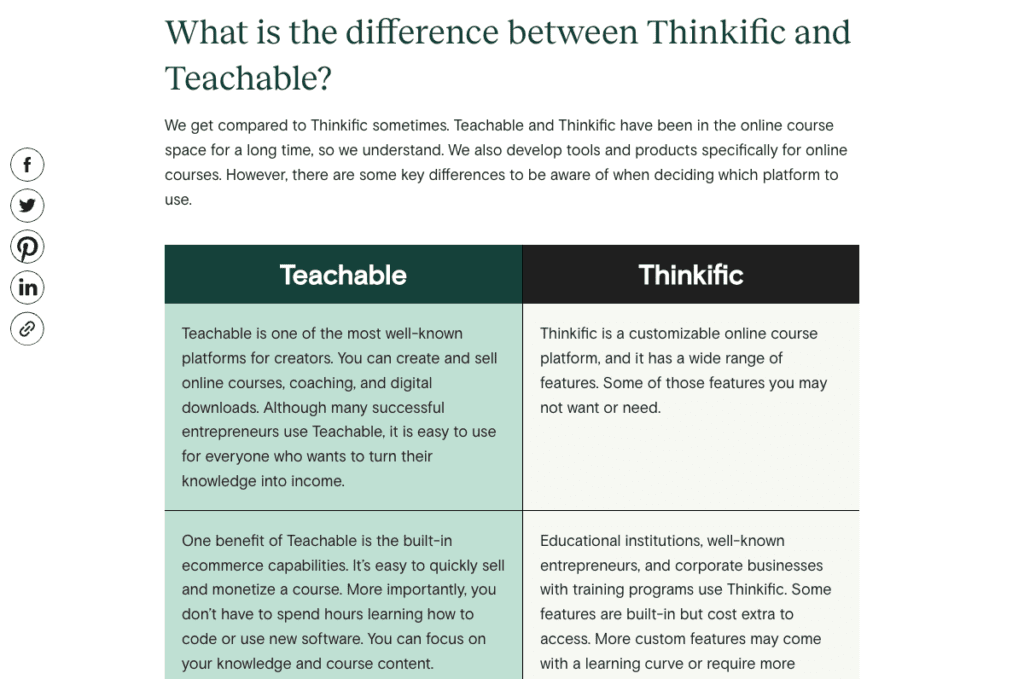
Source: teachable.com
Align Your Brand With Science
Shaping a positive brand reputation — especially when aiming to generate trust — depends on what voices you employ to convince your target audience that your business has their best interests at heart.
Consumer research shows there are various personas consumers consider trustworthy when it comes to representing businesses. For instance, Nielsen found in 2021 that 88% of buyers trust the recommendations of people they know. And in 2022, Oracle discovered that 37% of people trust social media influencers.
However, when trying to build credibility in industries — like health, tech, and finance, where trust is declining — the best way to generate brand trust is to align your brand with proven science.
Instead of making pompous claims, do your best to back up your promises with facts. Moreover, knowing that many businesses now use pseudoscience to sell products, you must differentiate your brand by enabling readers to check out the data for themselves.
For inspiration, you can look to Transparent Labs. Even though it sells supplements, this business goes out of its way to empower prospects with proven, no-nonsense facts about various compounds. In articles like their post on “What Is the Best Creatine Supplement”, Transparent Labs does its best to educate readers about the pros and cons of consuming creatine supplements, giving them the best possible nutrition advice based on research instead of guesswork (or wishful thinking).
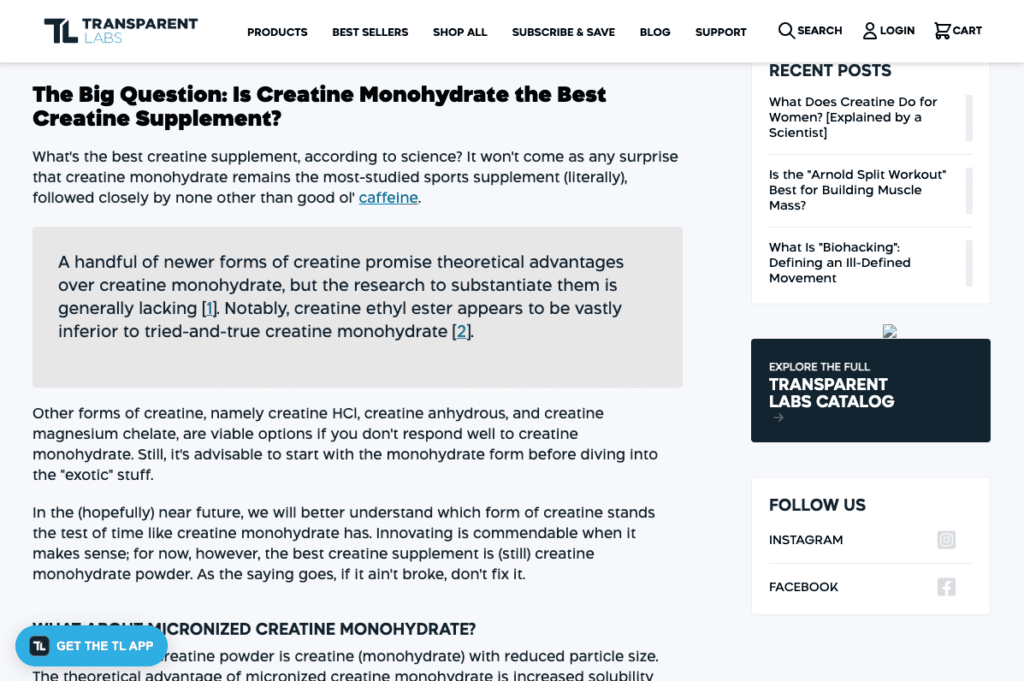
Source: transparentlabs.com
Highlight Your Brand’s Relatability
When using content marketing with the purpose of reputation management, you must give future customers the impression that your organization isn’t just another faceless corporation that only cares about profits.
Research shows that people want to build human-like relationships with brands. According to data from 2018, 57% of buyers say that feeling connected to a business boosts their loyalty. And 58% claim that they would spend more money with relatable brands.
In other words, consumers don’t want to feel like just another sucker who gave a business their money and got a mediocre product/service in return. They want to invest in solutions that make them feel like they’ve made the best buying decision ever. And they want genuine relationships with the businesses they buy from.
Therefore, if you want to shape your brand’s reputation in a way that will encourage and nurture a human-like connection, use content marketing to highlight your brand’s reliability and benevolence wherever you can.
For example, by doing something simple as supplementing blog posts with the author’s bio (and credentials, where relevant), you can show potential customers that your team consists of industry experts willing to share their insights for the sake of helping consumers make the right buying decisions.
This is what Healthline does with all of its content. In the “Should I Exercise With a Cold” article, the brand gives credit both to the author and the doctor who medically reviewed the resource and whose certifications readers can check out by clicking on their name.
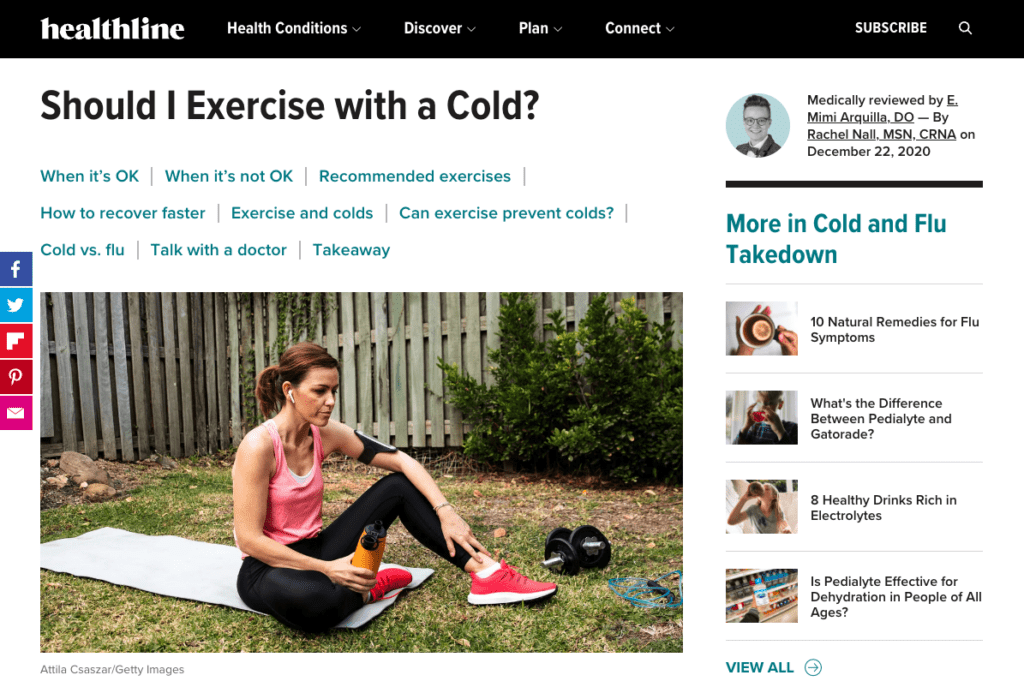
Source: healthline.com
Similarly, you can highlight brand relatability by giving prospects a glimpse into the behind-the-scenes workings of your organization.
If you check out the “Keeping Figma Fast” blog post, you’ll see that this brand regularly shares real-life stories. Not only does this boost approachability, but by explaining why certain features were developed or how the business sets its future improvement goals, Figma effectively ensures that customers understand where the software is heading.
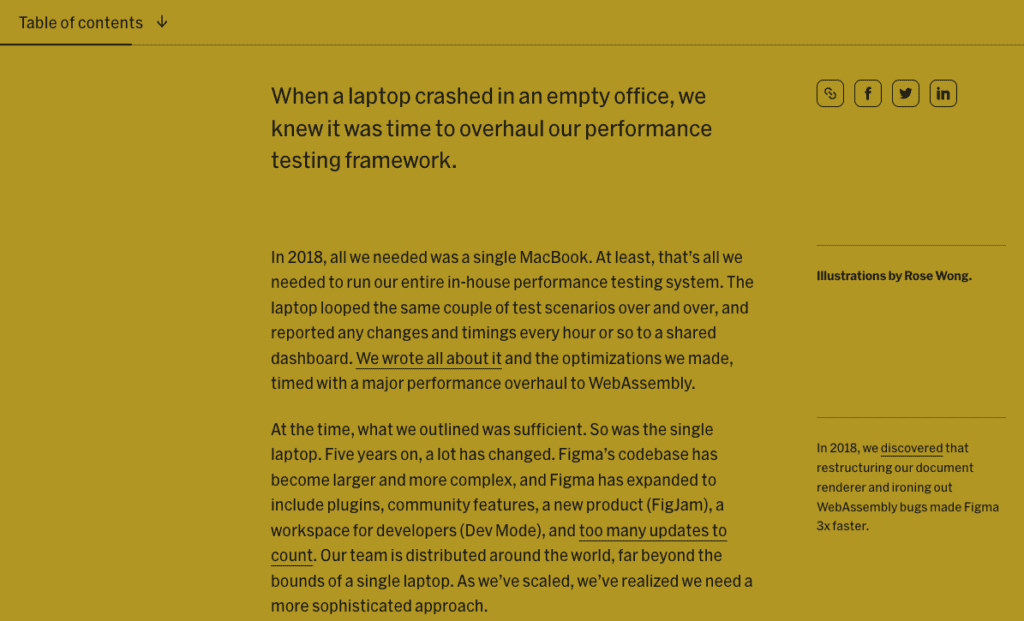
Source: figma.com
Show, Don’t Tell
It’s easy for businesses to make impressive claims about their products and customer service. However, overpromising (especially when followed by underdelivering) is a shortcut leading straight to a brand reputation management nightmare.
So, to position your business as credible, trustworthy, reliable, and customer-oriented, use content to show evidence for each of your claims.
By investing in differentiating content — like real-life examples of how your products work — you can effectively convince your target audience that you take customer interactions and satisfaction extremely seriously. This is particularly important to do in high-competition industries, especially as 69% of consumers expect brands to deliver better customer experiences.
Fortunately, implementing the “show, don’t tell” approach to shaping brand reputation is relatively easy to do — with the right content.
Bay Alarm Medical, for example, does it beautifully by allowing prospects to listen to real recordings of emergency calls on its “Medical Alert System” product page. This type of content effectively manages customer expectations and showcases the brand’s dedication to delivering the high quality of service it promises in its value propositions.
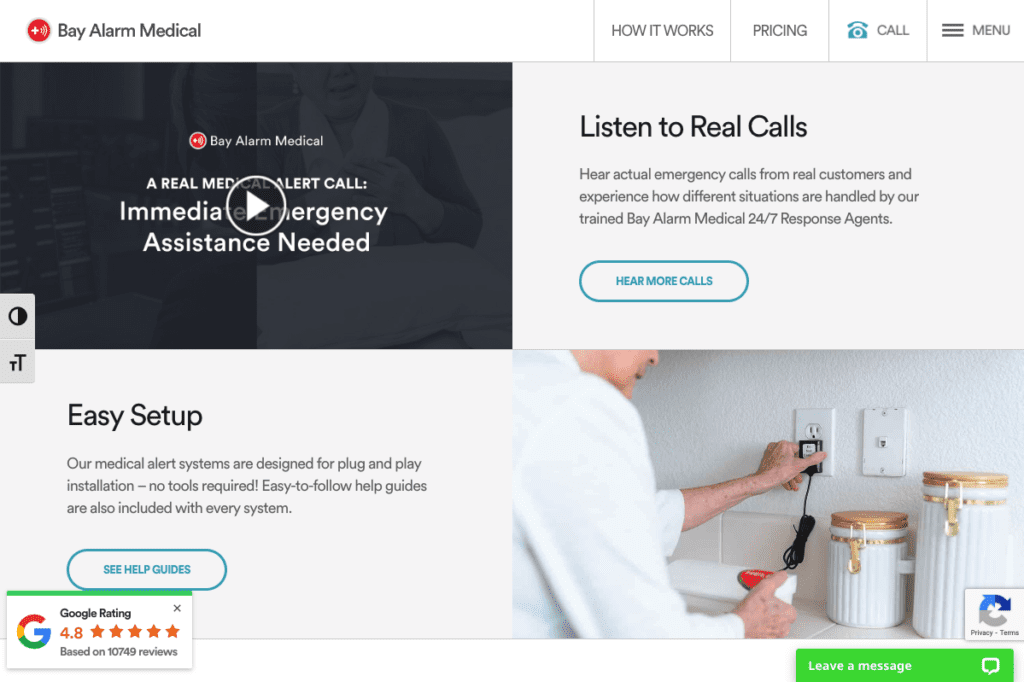
Source: bayalarmmedical.com
And Superhuman does something similar as well. This brand uses its blog to publish case studies delivered in a story format — like in the “How Superhuman Helps Notion Stay on Top of Email” blog post. They make it easy for potential customers to witness, first-hand, the benefits offered by this software solution.
Align Your Brand With A Desirable Lifestyle
When it comes to branding, one of the secret weapons many businesses try to employ is positioning their businesses’ products/services as aspirational. Knowing that 37% of global consumers fall into the category of shoppers who want new experiences and opportunities, aligning your brand with a desirable lifestyle is a great way to shape your reputation.
One of the best ways to do this is by investing in the right content marketing tactics.
By producing and distributing content that can show your audience that your brand is associated with a lifestyle they crave, you can effectively build an attractive reputation and use it to reach your business goals.
For instance, if you check out “The Ultimate Beginner’s Guide to Stand Up Paddle Boarding” article on the GILI site, you’ll see that this business earns the aspirational label by supplementing its written content with breathtaking product photos. Seeing how each image shows the brand’s products being used in beautiful settings, GILI effectively manages to create a natural and logical connection between the brand and a healthy, adventurous lifestyle.

Source: gilisports.com
Put Your Brand At The Forefront Of Industry Trends
One of the best ways to wow your target audience — whether that includes early adopters or those seeking dependability — is to showcase your organization’s commitment to innovation while meeting consumer demands.
By putting your brand at the forefront of industry trends, you can effectively show that you are a noteworthy entity in your niche, making significant contributions to predicting and meeting consumer needs.
Naturally, the best way to do this will be to focus on product development and customer experience. Nothing will communicate authority and dependability as effectively as highlighting that your solution works just as users expect it to and is backed up by a superstar customer service team.
However, when it comes to branding, you can use content to a great extent to show your prospects that investing in your products unlocks access to a superior experience.
Arguably, the best way to shape your brand’s reputation as an entity that sets industry trends (instead of merely trying to keep up with them) is to curate your social media content.
Don’t just react to the happenings in your business sphere. But do your best to continually show your followers that you’re doing things that genuinely move the needle.
For instance, Mannequin Mall regularly posts about noteworthy examples of visual merchandising on Instagram and Pinterest. And seeing how many of the posts include a dose of social proof — by showing the brand’s mannequins in the displays of fashion houses like Stella McCartney, Valentino, and Hermes — they do an exceptional job of showing just how notable Mannequin Mall’s contributions to the fashion industry are and supporting its claim of being the #1 online retailer of mannequins in the USA.

Source: instagram.com
Make An Effort With SEO-Focused Posts
Lastly, as you explore ways to shape brand reputation through content marketing, you must avoid one of the biggest mistakes in reputation management — pumping out SEO content, hoping it will boost organic traffic, but failing to understand how low-quality writing reflects on your brand.
When it comes to content marketing, optimizing for keywords is one of the best ways to maximize reach and ensure your target audience gets exposed to the articles testifying to your expertise and trustworthiness.
However, if you only focus on ranking for particular search terms without ensuring that your posts offer real value, that is going to backfire on your brand’s reputation.
With this in mind, when investing in SEO for your brand, make sure that the articles you publish deliver unmatched quality. Know precisely what questions your prospects want to be answered. Understand that how you approach specific topics will impact your brand’s reputation. And avoid, at all costs, the risk of coming off as careless or superficial.
For a great example of a business that knows how to shape a positive reputation — and differentiate itself from competitors only looking to make a sale — check out Eachnight’s “How Much Does a Mattress Cost” article. Instead of just providing a short-form answer to a question that gets a solid amount of monthly searches, Eachnight puts a tremendous amount of effort into presenting readers with an insightful, easy-to-understand 3,000-word post that genuinely helps consumers make the right buying decision.
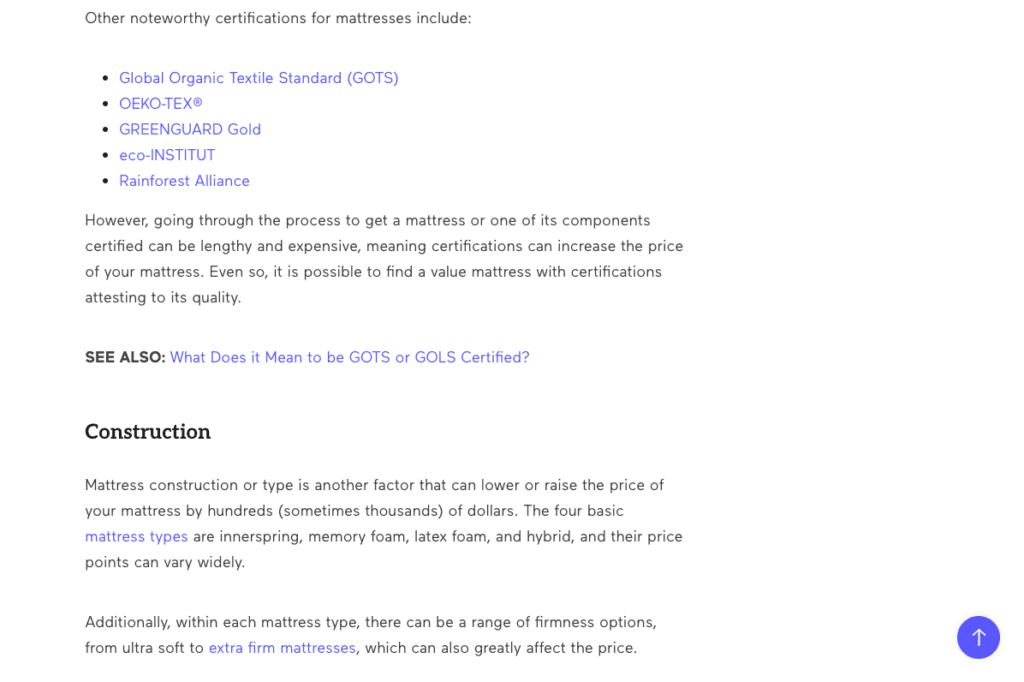
Source: eachnight.com
Final Thoughts
Investing in content marketing to shape your brand reputation is an exceptionally effective branding strategy.
After all, by focusing on producing high-quality posts, you won’t “just” ensure that your target audience discovers your solutions. More importantly, you can guarantee that they perceive your products and services as being the superior choice when compared to the competition.
Nonetheless, to get the best results from the tactics highlighted above, ensure that you know the precise brand image that will appeal to your target audience. Because most consumer groups have their specific wishes and priorities. And capturing (and retaining) their attention necessitates a super-in-depth knowledge of their wants, needs, and values. So, if you haven’t already, start your branding journey by defining who you want to reach and only move on to content production and distribution once you’re 100% sure that you know and understand your future customers’ needs.














